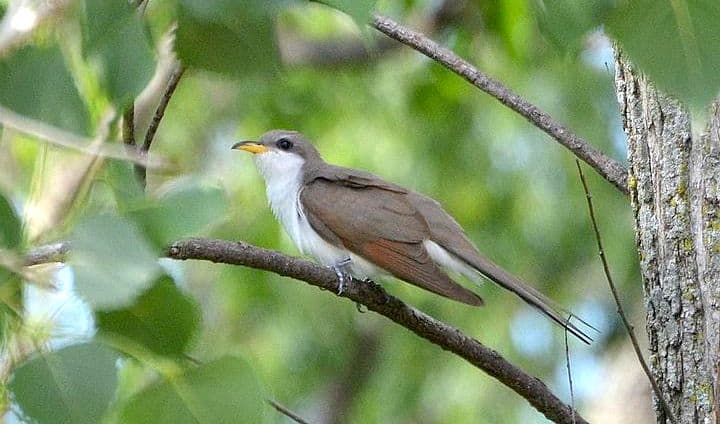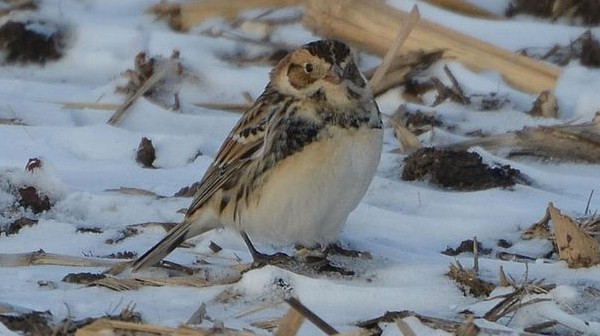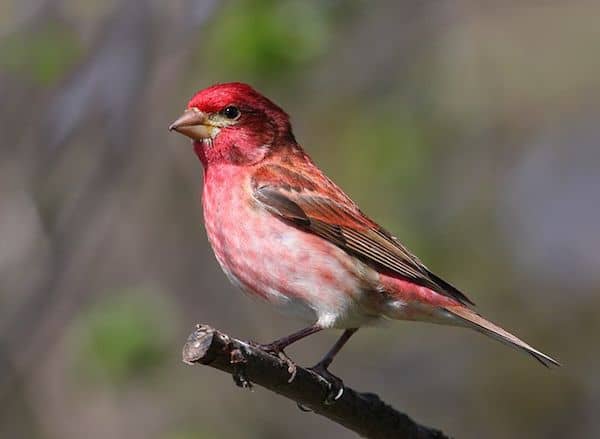Slender and long-tailed, the yellow-billed cuckoo has a plain brown back and creamy white breast. The underside of the tail shows a pattern of bold white spots against a black background, and bright rufous wing patches are visible in flight.
The lower part of the bill is yellow. Male and female yellow-billed cuckoos look alike. The only other species they are likely to be confused with is the related black-billed cuckoo, which lacks the rufous wing color and has a black bill, among other differences.
Listen for
The yellow-billed cuckoo makes a unique repetitive clucking sound that is a sure clue to identification. From deep cover, yellow-billed cuckoos give a hollow, hoarse, two-syllabled tee-oo, tee-oo, tee-oo in a series and a mechanical-sounding kik-kik-kik-kik-kaKOW, kaKOW.
Find it
The yellow-billed cuckoo is a furtive, skulking bird of thickets and brushy woodland edges and, though it is fairly large, its retiring habits make it far more easily heard than seen. It often hides deep within the foliage and, when perching in the open, it tends to remain very still.
Yellow-billed cuckoos inhabit deciduous woodland edges, thickets and tangles along water- courses or roadsides, willow groves, and overgrown orchards. Yellow-billed cuckoos are not generally found in deep interior woodlands, as they prefer some kind of “edge” to their habitat.
Feed it
Yellow-billed cuckoos eat great numbers of hairy caterpillars and many large insects such as dragonflies, cicadas, grasshoppers, crickets, and beetles. Small fruits are a minor but regular part of their diet in summer.
Most yellow-billed cuckoos forage by slowly and methodically exploring branches, twigs, and leaves for hidden insects. However, they occasionally may act like flycatchers, darting into the air for a meal on the wing, or hovering to seize a caterpillar at the edge of a leaf.
Nesting Behavior
Once paired, cuckoos survey the surrounding area for a leafy and secluded nest site, five to ten feet off the ground. Both help build a loose shell of twigs and stems, lining it with fine grasses. Three to five eggs are laid, and both parents share the incubation and feeding of the young. The entire process, from egg laying to fledging, takes only 17 days, one of the shortest such periods for any bird species.
WOW!
Because the yellow-billed cuckoo commonly sings on humid summer afternoons, the bird’s folk name is rain crow. Some believe that the bird can predict a coming rainstorm.





I live in pine woods in north Florida. Saw a yellow billed cuckoo in one of my crape myrtle trees yesterday evening. It sat on a low branch and carefully inspected the surrounding leaves and branches. It didn’t seem afraid of me when I stepped off the porch for a closer look. Eventually it hopped down to the bottom of the fence and ate several bugs or caterpillars. I’ve lived here 40 years and have never seen these birds, but hear them call often. When there’s going to be rain, they join the frogs and sing their hearts out. It was so cool to finally see one!